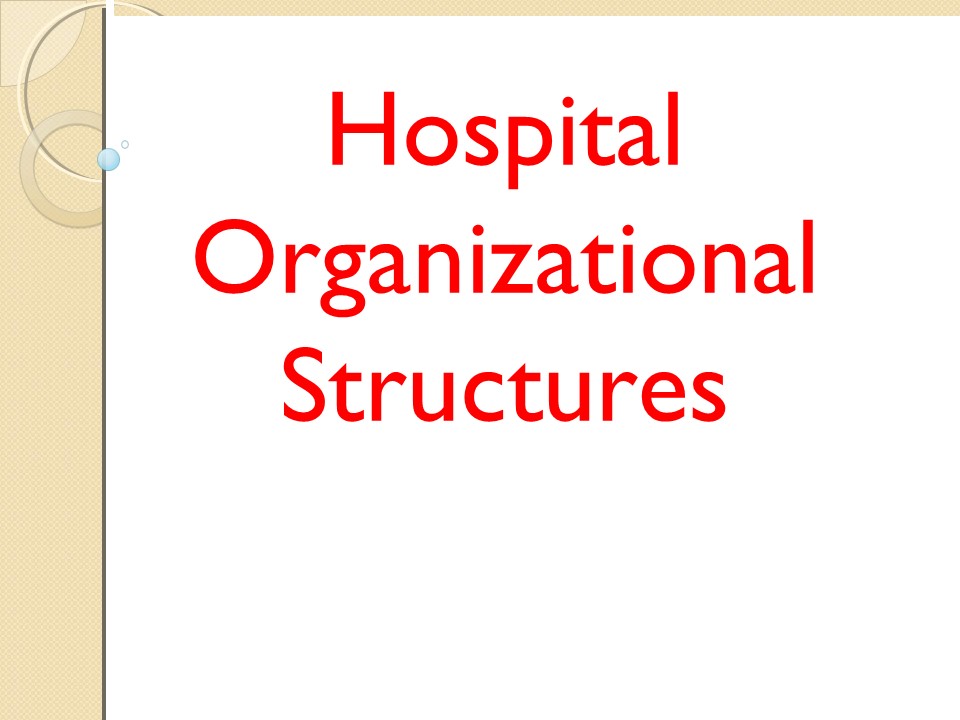HOSPITAL ORGANIZATION - PowerPoint PPT Presentation
Title:
HOSPITAL ORGANIZATION
Description:
HOSPITAL ORGANIZATION – PowerPoint PPT presentation
Number of Views:20
Title: HOSPITAL ORGANIZATION
1
Hospital Organizational Structures
2
- A hospital is a health care institution providing
patient treatment with specialized health science
and auxiliary healthcare staff and medical
equipment. - A hospital is a healthcare facility that provides
specialized medical and nursing care as well as
medical supplies to patients. T
3
CLASSIFICATIONS OF HEALTH CARE
- Primary Care
- Secondary Care
- Tertiary Care
4
Primary Care
Consists of basic
curative care,
including simple
diagnosis and
treatment, provided at the point of entry into
the health care system. (Example
walk-in-clinic)
5
Secondary Care
Consists of specialized sophisticated and com
plicated
care requiring more and
diagnosis
treatment than is provided at the primary health
care level. Normally involves hospitalization.
(Example Patient ward in general hospital)
6
Tertiary Care
Consists of highly specialized diagnostic and
therapeutic services which can usually only be
provided in centers specifically designed staffed
and equipped for this purpose. (Example
Neonatal intensive care unit)
7
CLASSIFICATIONS OF SERVICE
?GENERAL HOSPITAL ?SPECIALITY HOSPITAL ?REHABILITA
TION HOSPITAL ?LONG-TERM CARE HOSPITAL
(AUXILIARY) ?NURSING HOME
8
GENERAL HOSPITAL
?Provides primarily for the diagnosis and
short-term treatment of patients for a wide
range of diseases or injuries.
9
SPECIALITY HOSPITAL
?Provides primarily for the diagnosis and
short-term treatment of patients for a limited
range of diseases or injuries.
10
REHABILITATION HOSPITAL
?Provides for the continuing assessment and
treatment of patients whose condition is
expected to improve significantly.
11
LONG-TERM CARE HOSPITAL
?Provides primarily treatment of
for the continuing with long-term
patients
illness or with
a low potential for
recovery.
12
NURSING HOME
?Institution where residents are accommodated
who require nursing and personal care on a
continuing basis.
13
REGULATORY AGENCIES
- ?Provincial hospital authorities responsible for
- Approving hospital budgets
- Licensing and inspecting hospitals
- Health and safety of hospital workers
- ?Agencies regulating the various health
professions - ?Agencies approving various hospital based
training programs
14
A hospital is perhaps the most complex
organization in our society.
15
Professional Groups
?Medical Specialties ?Nursing Specialties ?Clinica
l Technicians (i.e., Lab Techs, X-Ray Techs,
Respiratory Therapists, Physiotherapists,
etc.) There are more than 200 health
occupations!
16
HOSPITAL ORGANIZATION
GOVERNING BOARD
MEDICAL STAFF ADMINISTRATOR
HOSPITAL ADMINISTRATOR
17
Hospital Management Model
?Governing Board (government appointed) ?Chief
Executive Officer (Hospital Administrator) ?Medic
al Staff Organization.
18
Functions of the Governing Board
- ?To determine the policies of the institution
within the context of community needs. - ?To provide equipment and facilities to conduct
patient care programs. - ?To see that proper professional standards are
defined and maintained. - ?To co-ordinate professional interests with
administrative, financial and community needs.
19
Functions of the Governing Board
- ?To provide adequate financing by securing
sufficient income and by enforcing business like
control of expenditures. - ?To provide for the safe administration of funds
given in trust, (e.g., gifts and contributions). - ?To maintain accurate records of its finances and
activities. - ?To surround the patient with a safe environment.
20
THE HOSPITAL ADMINISTRATOR
- ?Function is identical to that of the president
of any corporation. - ?Individual styles are judged to be successful
if the determined results further the
organization toward its goals.
21
Functions of the Hospital Administrator
?Submitting for board approval a plan of
organization and recommending changes when
necessary. ?Preparing a plan for accomplishing
the institutional objectives as approved by the
board and periodically reviewing and evaluating
it. ?Selecting, employing, controlling, and
discharging employees. ?Submitting for board
approval an annual budget.
22
Functions of the Hospital Administrator
funds of the
?Safeguarding the operating enterprise.
?Maintaining all physical properties (plant and
equipment) in safe operating condition. ?Represent
ing the hospital in its relationships with the
community and other health agencies. ?Serving as l
iaison between the board or its committees and
the medical staff.
23
Functions of the Hospital Administrator
?Assisting the
medical staff with its and administrative
organizational
responsibilities. ?Submitting to the board annual
reports which describe the nature and volume of
the services delivered during the past
year. ?Advising the governing board on matters
of policy formulation.
24
THE MEDICAL STAFF
25
Doctors represent the initiators of every action
that results in the direct provision of patient
care services.
26
Doctors determine
?Who Will Be Admitted ?When ?Where ?What Medical
Services Are to Be Provided, in What Sequence,
in What Dosage, With What Equipment and
Supplies When, Where and by Whom ?Who Is
Discharged and When.
27
Medical Staff
?Participation by the medical staff in the
decision-making process is in the best interest
of both the hospital and the patients. ?Physicia
n involvement leads to physician accountability.
28
Medical Staff
?The chief of medical staff is the elected
representative of the medical staff. ?The chief
of staff appoints all of the committees other
than the executive committee whose members are
elected by the staff or appointed by the board
administrator.
29
Functions of the Medical Staff
?To advise the governing body on medical
affairs. ?To accept accountability for the
quality of care rendered to patients in the
hospital. ?To request, review and act upon
reports of medical staff committees. ?To
scrutinize the professional ethics of its
members and to initiate corrective action as
indicated. ?To develop, implement, and review
medical staff policies.
30
Functions of the Medical Staff
- ?To recommend action to the administrator on all
medical- administrative matters.
31
THANK YOU































